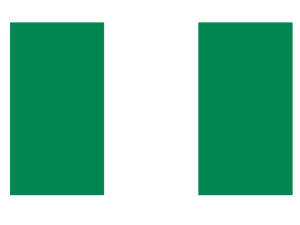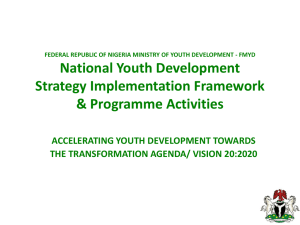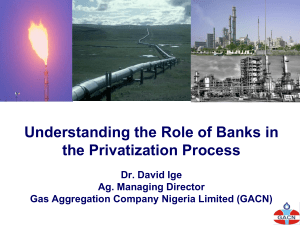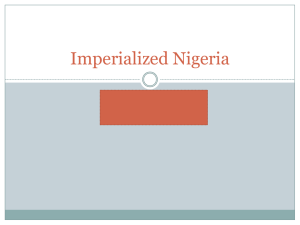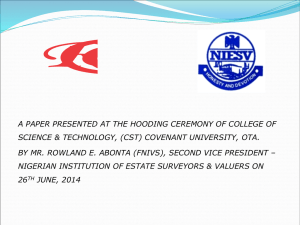WFL-FSI comparison in Two Niger Delta Wells
advertisement
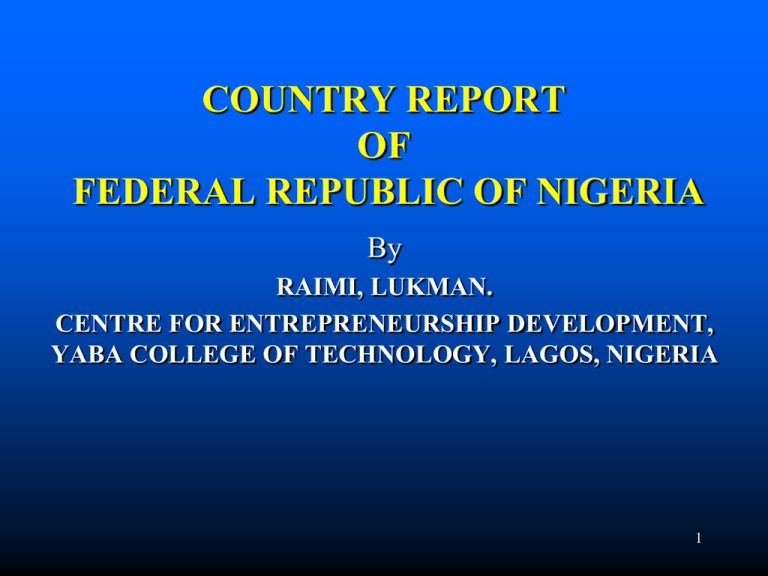
COUNTRY REPORT OF FEDERAL REPUBLIC OF NIGERIA By RAIMI, LUKMAN. CENTRE FOR ENTREPRENEURSHIP DEVELOPMENT, YABA COLLEGE OF TECHNOLOGY, LAGOS, NIGERIA 1 HISTORY OF NIGERIA Nigeria is a Federation of thirty-six (36) States and a Federal Capital Territory, Abuja. Lagos remains the commercial centre of Nigeria. It was under Colonial rule for years until 1st of October, 1960 when it gained independence from Britain. Nigeria was the creation of the colonial administration. In fact, it is was so-named by wife of Lord Lugard, Flora Shaw. The etymology of Nigeria is from the amalgam of the words Niger and Area. The country has more than 250 ethno-linguistic groups, but the three dominant groups are the Hausas in the North, the Ibos in the Southeast and Yorubas in the Southwest. It runs a Presidential System of Government. 2 NIGERIA’S MAP AND COAT OF ARMS 3 NIGERIA’S FLAG 4 MEANING OF COAT OF ARMS/FLAG The Coat of Arms of Nigeria has a black shield with two white stripes that come together, like the letter Y. These represent the two main rivers flowing through Nigeria: the Benue River and the Niger River. The black shield represents Nigeria's good earth while the two horses on each side represent dignity. The eagle represents strength, while the green and white bands on the top of the shield represent the rich agricultural land of the country. The flowers at the base are Nigeria's national flowers. The green stripes in our flag represent Nigeria's agriculture industry and its lush vegetation. The white stripe represents the desire for peace and unity within the country 5 ECONOMIC PROFILE • • • • • • • • • • • Endowed Land Area: 923,800 sq.km. Population: 149,229,090 (July 2009, CIA World Fact book.) 1 out of every 2 W.African is a Nigerian; 1 in every 6 Africans GDP (2007) is €124.1b, PCI is $2,400 (2009) or €886 GDP Growth Rate (2007): 6.2% ; 7.0% ave (2003-2007) Manufacturing capacity utilisa-tion (2007): 53.5% Inflation (2010) is 11.5% using consumer price index Exchange Rate (2007): N174/€1, N157/$1 External Reserve (2007): €35.1b or $46.54 billion (2009 ) Unemployment rate: 4.9% (2009) Gross external debt $9.689 billion 6 ECONOMIC PROFILE Religion: Islam, Christianity and Traditional Religion Language: English (Official), Igbo, Yoruba and Hausa Labour force 47.33 million (2009.) Labour force by occupation: Agriculture: 70%; Industry: 10%; Services: 20% (1999.) Main Export: Crude Oil External Exports $45.43 billion (2009.) Main export partners: United States 42%, Brazil 9.5%, India 9%, Spain 7.3%, France 5.1% (2008) Imports $42.1 billion (2009) Main import partners China 16.1%, Netherlands 11.3%, United States 9.8%, United Kingdom 6.2%, South Korea 6.1%, France 5.1%, and Germany 4.4% (2008) 7 FDI stock $71.59 billion (31 December 2009) MAJOR ECONOMIC ACTIVITIES 1. 2. 3. 4. 5. 6. 7. 8. 9. Oil & Gas the largest income earning sector Agriculture, the largest employers of labour Manufacturing Sector Telecommunication, fast growing/large market Construction Mining sector Music and Entertainment rising appreciably Tourism, is a potential less explored but rising Trade (Import and Export) engages most Nigerians 8 SECTORALGROWTH Sector Agriculture Mining and Quarrying Manufacturing Electricity, Gas & Water Construction Wholesale & Retail Trade, Restaurants, Hotels Finance, Insurance, Real Estate, etc. Transport and Communications Public Administration and Defense Other Services 2008 (%) 6.3 -5.9 8.9 4.0 13.1 2009 (%) 6.2 -1.0 8.5 3.6 12.9 14.0 11.6 6.8 19.3 4.4 10.3 6.4 20.9 4.5 10.0 9 CULTURE AND ARTS 10 ARGUNGUN FISHING FESTIVAL (NORTH) 11 IGBO NEW YAM FESTIVAL (EAST) 12 OJUDE OBA FESTIVAL (WEST) 13 CULTURE AND ARTS 14 HOME VIDEOS AND FILMS 15 SPORTS (FOOTBALL) 16 GOVERNMENT EFFORTS AT PROMOTING ENTREPRENURSHIP AND SMEs National Directorate of Employment (NDE) 2. National Poverty Eradication Programme (NAPEP) 3. The Peoples Bank (Defunct) 4. Community Banks (Defunct) 5. Small and Medium Enterprises Development Agencies of Nigeria (SMEDAN) 6. Raw Materials Research and Development Council 7. Nigerian Export-Import Bank 8. Federal Institute of Industrial Research, Oshodi 9. Nigeria Investment Promotion Commission (NIPC) 10. Nigerian Export Promotion Council (NEPC) 1. 17 POLICIES PROMOTING ENTREPRENURSHIP AND SMEs 1. 2. 3. 4. 5. 6. 7. 8. 9. 10. 11. 12. Indigenisation Policy Nigerian Enterprise Promotion Decree Export Promotion Policy Free-Trade Zone policy Fist National Development Plan Second National Development Plan Third National development Plan Fourth National Development Plan National Economic Empowerment Development Strategy Vocational Education Policy Entrepreneurship Education across Tertiary Institutions Micro-Finance Bank Policy Framework 18 PRIVATE SECTOR INTERVENTION AT PROMOTING SMEs IN NIGERIA Nigerian Association of Small Scale Industrialists (NASSI) National Association Of Small And Medium Enterprises (NASME) Nigerian Association of Chambers Of Commerce, Industry, Mines and Agriculture (NACCIMA) Manufacturers’ Association of Nigeria (MAN) Micro-Finance Banks (MFB) Cooperative Thrift and Credit Societies Trade Associations NGOs/Better life, FSP et cetera 19 REGULATORY AND WATCHDOG AGENCIES FOR CONTROL OF SMEs/INDUSTRY 1. 2. 3. 4. 5. 6. 7. 8. 9. Federal Environmental Protection Agency (FEPA) National Agency for Food and Drug Administration and Control (NAFDAC) Standards Organisation of Nigeria (SON) – ISO Corporate Affairs Commission (CAC) - Incorporation Central Bank of Nigeria (CBN) –MFI, MFB et Securities and Exchange Commission (SEC) National Insurance Commission (NICOM) Economic and Financial Crimes Commission (EFCC) National Drug Law Enforcement Agency (NDLEA) 20 FAILURES OF GOVERNMENT AND PRIVATE SECTOR’S EFFOERTS Some of these efforts were frustrated by lack of managerial wherewithal, lack of supervision, mischannelling of credit facilities, duplication of roles, mediocrity, nepotism, bureaucratic delays in policy implementation, frequent changes in government polices/programmes, bribery and corruption (Olaitan 2001; Adeyemi, 2008). 21 BALANCING GOVERNMENT & PRIVATE SECTOR INTERESTS Yaba College of Technology came in like other tertiary institutions in Nigeria to balance government interests with those of the private sector through practical enterprise development education for all Diploma students. Government Interests Private sector Interests 22 VISION “Our Vision is to be the leading Polytechnic in Nigeria by providing first-rate academic, professional and entrepreneurial education to our students who are empowered to make a positive impact on the technological and socio-economic development of the country”. 23 MISSION “Yaba College of Technology is for the training of Knowledgeable and Selfreliant Graduates, worthy in character and learning through effective teaching, innovative learning and research for better living”. 24 BRIEF ON YABATECH’S CAPACITY Yaba College of Technology is the first tertiary institution in Nigeria. It was established in 1947. It currently runs over 60 National and Higher National Diploma programmes under seven schools and 40 departments. The college caters for over 16,000 students and has over 1,500 staff. The Federal Government of Nigeria has accorded it a university status recently, the process of its conversion is being finalised by the National Universities Commission (NUC) 25 PHYLOSPHY OF ENTREPRENEURSHIP DEVELOPMENT In a bid to geometrically multiply the population of entrepreneurs in the society and set a pace as Africa's leading institution in terms of out-turn of students fully prepared and equipped to be job-creators, the College innovated Entrepreneurship Development Programme (EDP) . EDP is administered by the College as a compulsory subject at distinct stages of academic studies and thus has proven to be a unifying factor of students in the campus. We are sent here on the bill of the Centre to the tune of $12,000 to learn about Indian experiences. 26 CURRICULUM OF EDP EDP curriculum contains: Mentoring/Coaching/Re-orientation/Psychology Training on idea generation and its processes Reports and Proposal Writing for start-up Market Survey for start-up/Post start-up survey Case Study of entrepreneurs and nations Manufacturing of products by students (40%) Packaging and advertisement and Book-keeping Bi-annial Exhibitions and Fairs, Industrial tours Direct market/relationships management 27 SERVICES OF EDP EDP services include: Consultancy services to Industries – R & D Business Review/Feasibility Studies/Marketing Entrepreneurship Training/Development of workforce Facilitation of Exchange Programme (EDI, Songhai, PAU, UI, Oxford Brookes, British Council) Staff Skill Acquisition Programme Basic Trainings for artisans and drop-outs Project Supervision Production and Direct Marketing of Bread, Sachet water, paint, textile, bricks, architectural model etc 28 SELF RELIANT GRADUATES 29 SELF RELIANT GRADUATES 30 SELF RELIANT GRADUATES 31 COLLEG’S ICONS AND HERITAGE 32 AERIAL VIEW OF YABATECH 33 END NOTE Martin Luther King said: “Through our scientific genius we have made this world a neighbourhood; now through our moral and spiritual development, we must make of it a brotherhood.” . Despite all odds, Nigerians remain “Good People, Great Nation” 34 Thank you. Questions? 35


